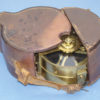Description
|
A MAJOR METAMORPHIC COMPENDIUM BY SCHMALCALDER, English, c. 1827. With structures of bright lacquered brass, the stowed compendium forms a compact drum 4″ across and 2″ thick (10 x 5 cm). One side has a large glazed prismatic compass, with tall folding sight vane, hinged and adjustable prism sight, green compass card printed with beautiful florally decorated 32-point rose and circumferential degree scale divided every 20 arcminutes and labeled in reverse with viewing through the lenticular prism. The card bears the signature “Schmalcalder¹s Patent, 82 Strand, London,” and with a faint manuscript correction to “399” Strand. There is a compass card arrestor, card lifter for stowage, and dust cover for the prism sight. Both the prism assembly and the tall sight vane are on clever swivel fittings, and can be brought into use on the other side of the drum, where a precision weighted inclinometer wheel is mounted under glass and suspended on a horizontal axle. The wheel is beautifully engraved “Schmalcalder’s Patent, 82 Strand, London” and very finely divided on the silvered (?) circumference, every 20 arcminutes from 0°±70°, and divided nonlinearly from 0±30 in a scale labeled “Diff. of Hypo. & Base” (i.e., “difference of hypotenuse and base,” being, as a function of inclination, the number of units longer a sloping terrain is than the underlying horizontal terrain). The weighted wheel can be temporarily arrested by push button, or can be secured for travel by inserting a thumbscrew at the 50° position. And for the pièce de résistance, a U-shaped staff mount can be inserted from either side of the drum, giving a choice of instruments for staff mounting. The compendium is in very fine condition, noting a little spotting on the inclinometer’s support members. Included is the original shaped leather case in good condition. In 1812 Charles Augustus Schmalcalder (c. 1786 – 1843) received Royal Patent 3545 (photocopy included) for the application of a right angle prism, with one of its sides ground spherically convex, to all manner of optical, surveying, and navigation instruments, in order to see a degree circle, for example, in the same view while sighting through the instrument . His simplest form of prismatic compass was a huge success, was made by various London instrument makers, and continues in basically the same form today. We have never, however, seen such a large, complex, versatile, and well-crafted form by Schmalcalder as the present compendium of twin prismatic instruments. It seems possible to date it fairly closely; Schmalcalder was listed at #82 Strand from 1810 until 1826, then at 399 from 1827. The handwritten address change on the compass card would indicate c. 1826 / 1827. |
Ask the Dealer
Dealer information
 TESSERACT
TESSERACT
David and Yola Coffeen both have enjoyed academic careers, as planetary astronomer and as linguist/educator. But since 1982 (yes, 1982!) they have been full-time dealers in early scientific and medical instruments, under the name Tesseract. Selling primarily by catalogue (over 100 issued so far) they also have a web presence at www.etesseract.com, and can be contacted at [email protected].














